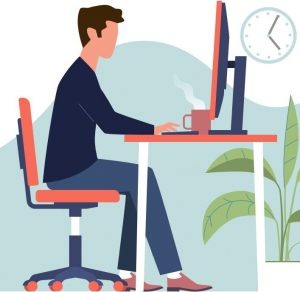
By Jacinta M. Jiménez, PsyD, BCC
*This is an article from the Summer 2021 issue of Contentment Magazine.
As a psychologist and executive leadership coach, my life’s work has been dedicated to helping people use psychological science to create a fulfilling work and personal life. Over the past several years however, I started to notice an alarming trend regarding today’s workforce: while the world of work is changing rapidly, we humans are not productively adapting alongside it. Changes such as hyper–connectivity and globalization have created an always-on-and-always-connected culture that has fundamentally altered how we live and work, but unfortunately, most of us (and the organizations in which we work) are still clinging to outdated formulas and ideas of what it takes to be and remain successful in work and life.
Long before the onslaught of COVID-19, burnout was a rapidly progressing global epidemic of its own. In 2015, Stanford University researchers estimated that job burnout has cost the U.S. economy up to $190 billion each year.1 In 2018, a Deloitte workplace burnout survey found that 77 percent of respondents have experienced burnout in their current job.2 In 2019, the World Health Organization included burnout in its International Classification of Diseases as an occupational phenomenon.3
Living through 2020 and witnessing the massive levels of disruption that happened in its wake has made this pressing issue even more alarming. In fact, the International Committee of the Red Cross found in a global survey that 51% of adults perceive that COVID-19 negatively affected their mental health.4
Perhaps the silver lining that may be found in this epidemic is that people are finally demanding more from their work: One of every two employees wants to see a greater focus on well-being at their company.5 As well, leaders are beginning to realize that employee well-being is no longer a nice-to-have, rather, it’s a strategic imperative tied to real business outcomes. A 2021 Fortune/Deloitte CEO Survey has found that an overwhelming majority of CEOs (98%) agreed that employee mental health and well-being will continue to be a priority even after the pandemic is resolved.6
One way we can begin to take measures to address this alarming burnout epidemic and the corresponding desires of employees, leaders, and organizations to enhance well-being is through what I refer to as the 3 R’s: Recognize, Respond, and Replenish.
Recognize: Know when you, your team, or your people are showing signs of burnout.
You cannot detect something if you’re not actively monitoring for it. Thanks to pioneering research by Christina Maslach and Michael Leiter,7 we know that burnout consists of three interrelated components:
- Exhaustion: Immense emotional, physical, and/or cognitive fatigue.
- Cynicism: Low levels of job engagement.
- Inefficacy: A lack of productivity and feelings of incompetence.
When these three components come together, burnout happens. It is important that both people, leaders and employees actively monitor for burnout. The sooner you can detect burnout, the more opportunity you have to course-correct early on.
Respond: Understand the six causes of burnout in order to effectively address it.
You may be surprised to learn that burnout isn’t simply a consequence of overworking to the point of exhaustion. For better or worse, too often burnout has been unnecessarily simplified in the mainstream. While overwork and exhaustion are part of what can happen with burnout, it is not the whole picture. Research8 has found that burnout comes from six distinct mismatches between people and their job:
- Work overload: The presence of high job demands and inadequate resources to complete the job.
- Perceived lack of control: Not being given the appropriate level of responsibility or not having access to the tools needed to do our jobs well.
- Insufficient reward: The lack of regular acknowledgment and/or financial, social, or intrinsic rewards for work efforts.
- Breakdown in community: High levels of workplace conflict and low levels of interpersonal trust.
- Lack of fairness: Unfairness in areas such as inequities in workload or pay, inappropriate handling of promotions or evaluations, and poor dispute-resolution practices.
- Values misalignment: Personal values and goals aren’t in alignment with those of the organization.
Through understanding which of the six areas is most impacting you, your people, and/or your organization, you can refine your approach to address this specific area (or areas) in order to respond most effectively. The more you are able to pinpoint the specific mismatch that is causing the most challenge, the more empowered you will be to strategically address and manage it.
Replenish: Build out a pro-resilience toolkit.
We are human beings, not machines. When we deny (or ask others to deny) our humanity for the sake of productivity, not only do we suffer, but our families, communities, and companies do too. In order to maintain our health, vitality, and well-being in our new world of work and life, we must actively work with (instead of against) our capacities as human beings. In my opinion, this is perhaps the most important R of the 3 R’s. A new world of work necessitates new ways to approach work; we need prevention, not reaction. In the same way we workout to build muscles at the gym to stay fit or brush our teeth daily to ensure healthy hygiene, we must proactively work to foster a fixed set of core resilience capabilities to keep us stable and grounded while the world of work continues to evolve around us.
The good news is that getting started on building out your pro-resilience toolkit does not require a large overhaul in behavior change. Rather, the key is look for small, realistic, and feasible behaviors that offer replenishment and proactively intersperse them throughout your schedule for the week. These are what I refer to these as “micro” (five – fifteen minutes) efforts that help you to either psychologically detach from work, relax, or replenish you. When practiced on a persistent and consistent basis, these small (but much more doable) practices can add up to a lot. In addition, it is important to find the right combination of pro-resilience practices that corresponds most with your current personal and professional goals. Remember, a personalized approach to building resilience is absolutely necessary for escaping burnout. Here are 3 quick examples of pro-resilience behaviors to get you started:
Integrate moments of calm into your day: Frustration, anger, and anxiety aren’t the only emotions that can leave you psychologically exhausted—things such as excitement, elation, and enthusiasm are also high-arousal emotions, which means that they, too, can leave you energetically drained. That’s right—regardless of whether you’re amped up with excitement or pumped full of anger, both states induce high physiologic arousal, which means they activate your nervous system. Too much tax on your nervous system will leave you drained of energy. 
Spend time in nature or take a moment to view pictures of nature: If we take an evolution-scale perspective, we humans have spent 99.99 percent of our time in nature. We’ve evolved to find restoration and relaxation in the sanctuary of nature. Research has found that taking as few as twenty minutes out of your day to connect with nature is enough to significantly reduce levels of the stress hormone cortisol.9
Take a few minutes to practice coherent breathing: The mind and body are intimately connected. It’s uncommon to have a totally revved-up body and a serene mind, nor a mind running on overdrive with a body that is super relaxed. For maximizing relaxation, try calming your body through coherent breathing, which consists of slowing your breathing down to five or six full breaths per minute, with equal-length inhalations and exhalations. Studies have found that this particular method of breathing is linked to increase in cognitive performance and a decrease in stress.10
As we emerge from the aftermath of COVID-19 and eventually enter into the post-pandemic world, we need leaders, organizations, and individuals across all industries step up to ensure that as we work to innovate, create new technologies, and address some of the world’s biggest problems, that people aren’t having to compromise their well-being in the process. Research shows that we can sustain our success while also doing great work in the world. In fact, when we have more resilience, we do better work. At the end of the day, vibrant workplaces require leaders to develop cultures that apply the most insightful lessons of psychological science to design an employee experience that inspires everyone to tap into their core resilience capabilities.
References
- Goh, Joel & Pfeffer, Jeffrey & Zenios, Stefanos. (2015). The Relationship Between Workplace Stressors and Mortality and Health Costs in the United States. Management Science. 62.
- Deloitte Touche Tohmatsu, Ltd., “Deloitte Workplace Burnout Survey: Burnout Without Borders,” 2018, www2.deloitte.com/us/en/pages/about -deloitte/articles/burnout-survey.html.
- World Health Organization, “Burn-Out an ‘Occupational Phenomenon’: International Classification of Diseases,” May 28, 2019, www.who.int/ mental_health/evidence/burn-out/en/.
- “Crisis within a Crisis: Mental Health Distress Rises Due to COVID-19.” International Committee of the Red Cross, www.icrc.org/en/document/crisis-mental-health-COVID-19. Accessed 12 Feb. 2021.
- Mercer, “2018GlobalTalentTrendsStudy,” www.fsgplus.com/fsgplus/news/hr_insight/201805/P020180515513270762947.pdf.
- “For CEOs, 2021 Is the Year of Hope.” Deloitte United States, 29 Jan. 2021, www2.deloitte.com/us/en/pages/chief-executive-officer/articles/ceo-survey-looking-ahead-post-pandemic.html.
- Maslach, Christina, and Michael P Leiter. “Understanding the burnout experience: recent research and its implications for psychiatry.” World psychiatry: official journal of the World Psychiatric Association (WPA) vol. 15,2 (2016): 103-11. doi:10.1002/wps.20311
- Maslach, Christina, and Michael P. Leiter. The Truth About Burnout: How Organizations Cause Personal Stress and What to Do About It. San Francisco, Calif: Jossey-Bass, 1997. Print.
- MaryCarol R. Hunter, Brenda W. Gillespie, Sophie Yu-Pu Chen, “Urban Nature Experiences Reduce Stress in the Context of Daily Life Based on Salivary Biomarkers.” Frontiers in Psychology 10:722 (2019).
- Richard P. Brown, Patricia L. Gerbarg, and Fred Muench, “Breathing Practices for Treatment of Psychiatric and Stress-Related Medical Conditions.” Psychiatric Clinics of North America 36(1): 1121-140 (2013).
ABOUT THE AUTHOR

Jacinta M. Jiménez, PsyD, BCC (also known as “Dr. J”) is an award-winning Psychologist and Board-Certified Leadership Coach with a 15+ year career dedicated to the betterment of leaders. She is the author of the bestselling book, The Burnout Fix(McGraw Hill, 2021), an evidence-based resilience toolkit to help find better, more sustainable ways to succeed at work and life. A graduate of Stanford University and the PGSP-Stanford PsyD Consortium, Dr. J is a sought-after expert in bridging the fields of psychology and leadership.
Contentment Magazine
The dictionary defines “content” as being in a state of peaceful happiness. The AIS magazine is called Contentment because we want all of our guests and members to find contentment in their lives by learning about stress management and finding what works best for each them. Stress is unavoidable, and comes in many shapes and sizes that makes being in a state of peaceful happiness seem like a very lofty goal. But happiness is easy to find once you are able to find ways to manage your stress and keep a healthy perspective when going though difficult times in life. You will always have stress, but stress does not always have you!
